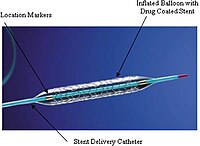
Photo from wikipedia
Objectives Our aim was to evaluate the safety and efficacy of biodegradable polymer everolimus-eluting stents (BP-EES) compared with durable polymer everolimus-eluting stents (DP-EES) in midterm. Background There are few data… Click to show full abstract
Objectives Our aim was to evaluate the safety and efficacy of biodegradable polymer everolimus-eluting stents (BP-EES) compared with durable polymer everolimus-eluting stents (DP-EES) in midterm. Background There are few data about midterm clinical outcomes of BP-EES compared with DP-EES. Methods and Results Between January 2016 and December 2017, 395 consecutive patients were treated with BP-EES and 391 consecutive patients were treated with DP-EES in Nagoya Heart Center. The primary endpoint was a 3-year cumulative incidence of target lesion failure (TLF) defined as cardiac death, target vessel myocardial infarction (MI), and clinical indicated target lesion revascularization (TLR). Moreover, clinical indicated target vessel revascularization (TVR) and definite stent thrombosis (ST) were also evaluated as the secondary endpoints. After propensity score matching, 327 patients were selected in each group. At 3 years, the cumulative incidence of TLF was 4.5% in the BP-EES group versus 6.5% in DP-EES (adjusted HR 0.67 (95% CI 0.33–1.30), log-rank P=0.23). Regarding the individual components of the TLF at 3 years, the cumulative incidence of target vessel MI was significantly lower in BP-EES than in DP-EES (0% versus 1.9%: adjusted HR 0.83 (95% CI 0.71–0.97), log-rank P=0.01), but there was no difference between BP-EES and DP-EES in the incidence of cardiac death and clinically indicated TLR. The cumulative 3-year incidence of definite ST was significantly lower in BP-EES than in DP-EES (0% versus 1.6%, log-rank P=0.02). Conclusions There were no significant differences of TLF between BP-EES and DP-EES within 3 years. In this study, BP-EES seems to prevent definite ST and be safer than DP-EES in midterm.
Journal Title: Journal of Interventional Cardiology
Year Published: 2020
Link to full text (if available)
Share on Social Media: Sign Up to like & get
recommendations!